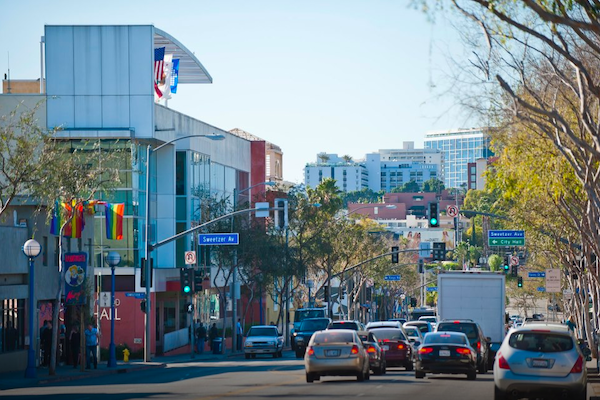
West Hollywood’s population has remained relatively static since 2000. However, the makeup of the city has evolved, with the Russian-speaking population continuing to decline, the percentage of residents who are men increasing, and the population of children ages five to nine increasing.
Those are a few of the findings from the city’s 2019 Community Study, which was released Tuesday. The Community Survey is compiled from data from the U.S. Census Bureau’s 2016 five-year American Community Survey and findings from telephone and online surveys of 738 residents, pop-up workshops at various locations throughout West Hollywood, focus groups, and interviews with community leaders.
The information compiled in the Community Study is used by the city to determine funding priorities for its social services programs.
In an announcement of the survey’s release, the city said that that “85% of respondents rated their quality of life as excellent or good. These respondents also tend to be satisfied with various aspects of life in the City of West Hollywood and indicate that social services are of high importance.” In coming days, WEHOville will provide more details from the extensive study. Below are a few of those findings.
Survey Findings
— Population (35,661), households (22,232) and average household size (1.6) have remained nearly level in West Hollywood since 2000;
— Men make up 58% of the population, a rate that has increased slightly since 2010;
— The number of single-person households (58%) has decreased by 3% since 2010, but single-person households remain the most common type of household in West Hollywood. Two-person households comprise the second largest proportion of household sizes (35%) and have experienced a 5% increase since 2000.
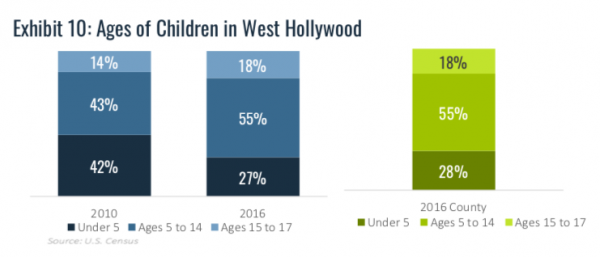
— The proportion of children in West Hollywood has decreased by 1% since 2010. Four percent of the population are children, compared to 23% in Los Angeles County overall. The number of households of families with children also has slowly decreased, but the number of children ages five to nine has increased;
— Since 2010, the city has experienced a slight increase (2%) in renter-occupied housing units (80% in 2016 versus 78% in 2010);
— West Hollywood residents continue to have achieved a higher level of education than Los Angeles County as a whole;
— Unemployment has decreased slightly but has remained consistent since 1980;
— The percentage of children living with families with incomes below the poverty level has decreased from 17% in 2010 to 7% in 2016;
— The median household income has increased by $9,000 since 2010 ($52,009 in 2010 versus $61,127 in 2016). West Hollywood’s median household income is about $3,000 higher than that of Los Angeles County’s ($57,952);
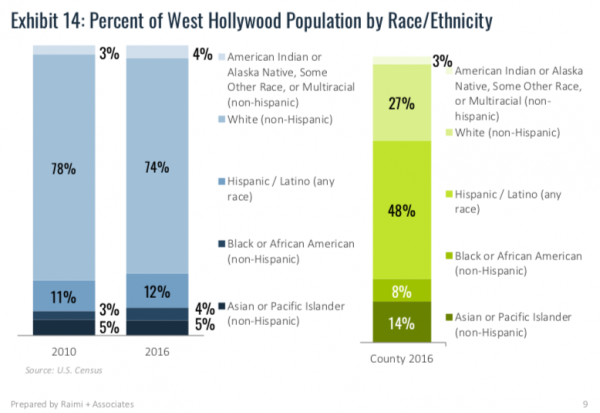
— The percentage of West Hollywood residents who identify as non-Hispanic white has decreased slightly since 2010, (from 78% to 74%) while the percentage of those who identify as black, Latino, and “other” has increased slightly. Compared to Los Angeles County, West Hollywood continues to be much less racially diverse;
— The population of immigrants from countries of the former Soviet Union continues to decrease, from 15% in 2000 to 8% in 2016;
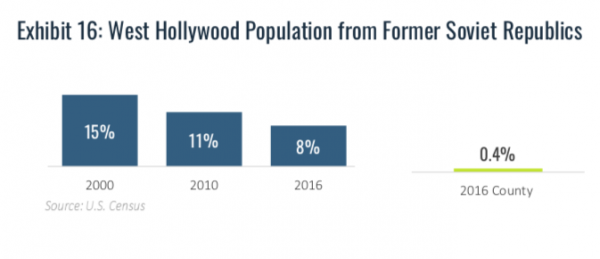
— Forty-three percent of West Hollywood residents identified as part of the LGBTQ community in the Community Survey, with 33% identifying as gay men, 4% identifying as lesbian, 3% identifying as bisexual, and 3% identifying as sexually fluid. Approximately 52% identified as heterosexual.
Health Status and Issues
The Community Survey also includes U.S. Census, California, and Los Angeles County health conditions data as well as information from the city’s Social Services Division. The health conditions data shows the following:
— West Hollywood residents live longer and have lower rates of adult obesity and chronic diseases than L.A. County residents;
— The rate of residents living with HIV is 14 times higher in West Hollywood compared to LA County overall (6,922.7 per 100,000 residents in West Hollywood compared to 491.7 per 100,000 residents for Los Angeles County overall);
— Rates of diabetes mortality, stroke mortality, and coronary heart disease mortality were well below Los Angeles County averages;
— West Hollywood residents are smoking less (11% in 2015 versus 19.6% in 2010);
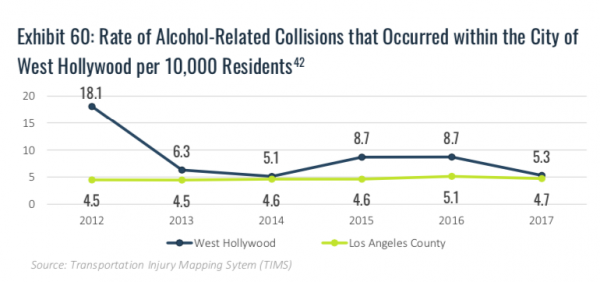
— West Hollywood continues to have higher motor vehicle injuries and deaths involving alcohol than does LA County as a whole, even though they have gone down since 2012.
Survey respondents identified senior services and services for the LGBTQ community, for children, youth and families, and for community members with disabilities as the most important. Transportation services, poverty reduction services (e.g., job training), and legal services were also cited as being very important.
In addition, Community Study participants identified affordable housing, health care, food insecurity, mental health, substance use, homelessness, HIV/AIDS, and sexually transmitted infections as being important issues for the city to address through Social Services funding.
The city’s Social Services Division budgets more than $5 million annually to support programs including alcohol and drug use recovery, programs that serve Russian-speaking and other immigrants, services for people who are homeless, food programs, and health care services for people who are uninsured or under-insured. Services are provided

I’d like to see the current age distribution. When WeHo was my stomping grounds in the mid to late 80’s, it seemed that everyone there was younger. It’s still a super cool place. But, the percent of owner occupied homes today is way too low (<20%), and all of the businesses and buildings on SM Blvd are too clean and modern and expensive and impersonal. I liked the 1980's "funkiness" of the bars and gay-centric shops where you could really talk to the guys behind the counter. It's all corporate today and not very gay any more.
In the early 1990s,I considered moving to West Hollywood as it seemed very welcoming to a guy like me.The city was made out to be a gay Camelot in those days. Unfortunately,my commute time would have increased to an hour or more. Another factor was having to buy a new place and deal with a new mortgage.I was living in a small home and had a satisfactory mortgage that I could handle.I didn’t care for condominium living,so that was another factor for me. After a while,I decided to stay put and not move to West Hollywood.I am glad I decided… Read more »
A few surprises here! Very interesting.
A few surprises here! Very interesting!
It is no surprise to me that West Hollywood is majority white per this survey.I have seen it for the last 25 years.That gay men are the majority as well is no surprise either.West Hollywood is small enough to do all the wonderful things (the arts,greater attention on HIV, LGBTQ services,etc.) that the larger LA cannot do.If the larger city tried to do the same things West Hollywood is successful at,it would fall flat on its face.